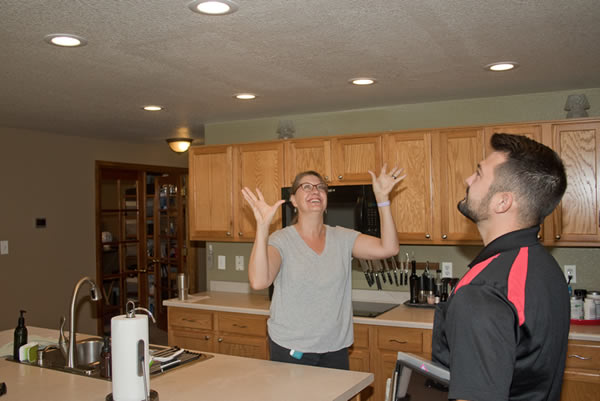Picture this: you’re hosting a dinner party, the table is set, and everything looks perfect. You hit the switch for your recessed lights to create that warm, inviting ambiance, but nothing happens.
Suddenly, your beautifully lit scene is plunged into darkness, and you’re left wondering, “Why are my recessed lights not working? ” Frustrating, right? You’re not alone. Many homeowners face this issue, and it can be both puzzling and inconvenient. But don’t worry; we’re here to shed some light on the problem.
We’ll guide you through the common reasons why your recessed lights might be acting up and how you can fix them. By the end, you’ll be ready to illuminate your space once again and ensure your home stays bright and welcoming. Let’s dive in and get those lights shining!
Common Causes
Recessed lights can transform a space, offering a sleek, modern look. But when they stop working, it can be frustrating. Understanding the common causes of recessed lighting issues can help you troubleshoot effectively. Let’s dive into some typical culprits that might be behind your lighting woes.
Burned-out Bulbs
Sometimes, the problem is as simple as a burned-out bulb. It’s easy to overlook, especially if your recessed lights are part of a larger set. You might assume a bigger issue, but often replacing the bulb solves the problem. Try swapping out the bulb with a new one and see if the light comes back on.
Faulty Wiring
Faulty wiring can disrupt your lighting system. Loose connections or damaged wires can prevent electricity from reaching your lights. This can be dangerous, so check the wiring safely. If you’re not comfortable doing this, consider hiring a professional electrician. Ensuring secure connections can restore your lights and reduce fire hazards.
Tripped Circuit Breaker
A tripped circuit breaker might be the reason your recessed lights are out. Check your home’s electrical panel to see if any breakers have flipped. Resetting the breaker could bring your lights back to life. If the breaker continues to trip, it might indicate an overload or short circuit, requiring further investigation.
Transformer Issues
If your recessed lights use a transformer, this could be the problem. Transformers convert electricity to a suitable voltage for your lights. A faulty transformer can lead to lights not working. Check if the transformer is operational and replace it if necessary. This component is crucial for maintaining consistent lighting.
Think about the last time your recessed lights stopped working. Did you panic, or did you methodically check each possible cause? Next time, tackle the issue step-by-step. Each cause mentioned here offers a straightforward solution. Which one resonates with your current situation?

Credit: diy.stackexchange.com
Safety Precautions
Dealing with recessed lights that aren’t working can be frustrating, but before you dive into troubleshooting, it’s crucial to prioritize your safety. Handling electrical fixtures requires caution to prevent accidents or injuries. Whether you’re a seasoned DIY enthusiast or a first-timer, safety should always be your first concern. Let’s look at some essential safety precautions you should take before getting started.
Turn Off Power
Always begin by turning off the power to the area where the recessed lights are located. This step is non-negotiable. You can do this by flipping the circuit breaker switch in your electrical panel. It’s a simple action that can prevent electric shock. Remember, even if the light isn’t working, the wires might still be live.
Use Insulated Tools
When working with electrical components, using insulated tools can be a lifesaver. These tools are designed to protect you from electrical shocks. Imagine trying to fix your lights with regular screwdrivers and accidentally touching a live wire—it’s not a risk worth taking. Investing in insulated tools is a small but wise decision for your safety.
Wear Protective Gear
Wearing protective gear, like rubber gloves and safety goggles, is essential when dealing with electrical repairs. You might think gloves are only for keeping your hands clean, but they also insulate you against electrical currents. Goggles protect your eyes from sparks or debris. Have you ever been startled by an unexpected spark? Protective gear ensures you’re prepared for the unexpected.
Addressing why your recessed lights aren’t working is important, but ensuring your safety while doing so is paramount. What other safety measures do you consider when working with electrical fixtures at home? Share your thoughts and experiences below!
Initial Checks
Discovering that your recessed lights are not working can be frustrating. Before calling an electrician, perform some initial checks. These simple steps might save time and money. Start with the basics. You might find the solution without any professional help.
Inspect The Bulbs
Begin by examining the bulbs. Ensure they are tightly screwed in. Loose bulbs might not make contact. Check for signs of damage or burn marks. If the bulb looks fine, try replacing it. Use a known working bulb. Sometimes, the simplest solution is the best.
Check The Switch
Next, inspect the light switch. Make sure it is in the ‘on’ position. Test the switch by toggling it several times. If the switch feels loose, it might be faulty. A broken switch can prevent electricity from reaching the lights. Consider replacing the switch or consulting a professional.
Verify Power Supply
Ensure the power supply is active. Check the breaker box for any tripped circuits. Reset any tripped breakers. A power surge might have caused the trip. Confirm that other electrical devices in the room are working. If not, there may be a larger electrical issue.
Troubleshooting Steps
Recessed lighting can add a sleek and modern touch to any room. However, when your recessed lights suddenly stop working, it can be both frustrating and inconvenient. Before you call in a professional, there are a few troubleshooting steps you can take to potentially solve the problem yourself. Let’s dive into these simple yet effective methods to get your lights shining bright again.
Reset The Breaker
One of the first steps is to check your electrical panel. It might sound too simple, but sometimes the solution is just a breaker reset. Locate your home’s electrical panel and look for any switches that aren’t aligned with the others.
If you find a tripped breaker, switch it off and then back on. This action resets the circuit and might restore power to your recessed lights. It’s a quick fix that can save you time and money. Have you ever had a simple solution to a problem that seemed complicated?
Examine The Wiring
If resetting the breaker doesn’t work, the issue might lie with the wiring. Carefully remove the light fixture to inspect the wiring connections. Look for loose wires, burnt spots, or any obvious damage.
Ensure all connections are secure and intact. If you’re unsure, using a voltage tester can help determine if the wires are live. Sometimes, a loose connection could be the culprit, and a simple tightening can do the trick.
Test The Transformer
Many recessed lighting systems use a transformer to adjust the voltage. If your lights still aren’t working, it’s time to test this component. Locate the transformer, usually found near the light fixture or in the ceiling space.
If you have a multimeter, check to see if the transformer is outputting the correct voltage. A faulty transformer might need replacement. Getting a professional opinion might be wise if you’re uncertain. It’s essential to ensure you’re addressing the right issue.
Tackling electrical issues can be daunting, but with a careful approach, you can often find and fix the problem on your own. Remember, safety first; if you’re ever unsure, don’t hesitate to consult an expert.
Replacing Components
Recessed lights offer a sleek, modern look to any room. But they can cause frustration when they stop working. Replacing components is often necessary to restore function. Let’s explore some common fixes.
Install New Bulbs
First, check the bulbs in your recessed lights. They may have burned out. Remove the old bulb by twisting it gently. Install a new bulb of the same type and wattage. Ensure the bulb is seated properly in the socket. Test the light to see if it works.
Fix Or Replace Wiring
Wiring issues can also cause lights to fail. Inspect the wiring connections for damage or loose ends. Turn off the power before touching any wires. Tighten loose connections with a screwdriver. Replace damaged wires with new ones. Test the lights after securing all connections.
Swap Out The Transformer
If the lights still don’t work, the transformer might be faulty. This component converts power for your lights. Locate the transformer in the lighting system. Disconnect it carefully and replace it with a new one of the same specifications. Ensure all connections are secure before testing the lights again.

Credit: cbpetersenelectric.com
When To Call A Professional
Experiencing issues with recessed lights can be frustrating. If changing bulbs or checking the circuit breaker doesn’t solve it, call a professional to ensure safe and efficient repair. Faulty wiring or electrical problems may require expert attention to avoid hazards.
When your recessed lights refuse to illuminate your space, it can be more than just an inconvenience. While some issues can be addressed with a simple bulb replacement or switch flick, other problems demand a professional touch. Knowing when to call in an expert can save you time, money, and ensure your safety. Let’s dive into the scenarios that warrant professional help.Persistent Issues
If your recessed lights keep flickering or going out despite changing bulbs and checking connections, this is a red flag. It might indicate wiring issues or faulty fixtures. You might have tried everything in your DIY toolkit, but the problem persists. This is the moment to consider a professional’s expertise. They have the tools and knowledge to diagnose the root cause effectively. Think about it: how often have you solved a complex problem without the right tools? Sometimes, a professional touch is just what you need to restore your lighting to full glory.Complex Electrical Problems
Recessed lighting involves more than just bulbs and switches. It’s a web of wires and circuits that can be confusing. If you’re not familiar with this, it’s easy to make mistakes that could cause more harm than good. For example, dealing with a tripped breaker or blown fuse isn’t just about flipping a switch. It could be a sign of a deeper electrical issue. A professional can pinpoint and fix the problem quickly, minimizing downtime. Tackling these issues yourself can lead to unwanted surprises. Are you prepared for the risks? Sometimes, a little help goes a long way in ensuring your electrical system’s health.Safety Concerns
Electrical work is risky. Handling it without proper knowledge can lead to accidents, such as electrical shocks or fires. Your safety is paramount. If you’re unsure about the problem, it’s best to err on the side of caution. A professional electrician can ensure that all work complies with safety standards, giving you peace of mind. Think of it as an investment in your home’s safety and functionality. Would you risk your safety for a DIY attempt, or would you prefer a job done right the first time? In summary, while DIY fixes can be tempting, knowing when to call a professional can save you from unnecessary headaches and potential hazards. Your home deserves the best care, and sometimes that means calling in the experts.
Credit: www.tituselectricians.com
Frequently Asked Questions
Why Are My Recessed Lights Flickering?
Loose connections or faulty bulbs can cause flickering. Check wiring and replace the bulb if needed.
How Do I Troubleshoot Recessed Lighting Issues?
Start by checking the bulb and switch. Inspect the wiring for damage. Call an electrician if unresolved.
Can A Blown Fuse Affect Recessed Lights?
Yes, a blown fuse can disrupt power. Replace the fuse to restore lighting functionality.
What Should I Do If Lights Won’t Turn On?
Ensure the bulb is properly seated. Check the circuit breaker for any tripped switches.
Why Is One Recessed Light Dimmer Than Others?
A worn-out bulb or faulty dimmer switch may be the cause. Replace the bulb or check the switch.
Conclusion
Fixing recessed lights can seem tricky. With patience, it gets easier. Check connections and bulbs first. Test your circuit breaker. It might be the problem. Consider hiring an electrician if unsure. Safety comes first with electrical issues. Regular maintenance avoids future troubles.
Keep your tools handy. They help with quick fixes. Understanding light systems boosts confidence. You’ll manage issues better next time. Remember, lights enhance home comfort. Proper function is key. Enjoy bright and welcoming spaces. Happy troubleshooting!




